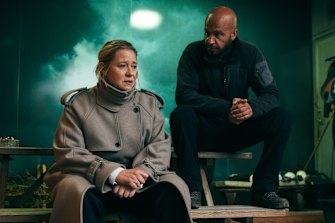
Face to Face ★★★★
Rogue cop. Dead girl. So far, so yawn. But this exquisite psychological thriller – two seasons are screening on demand and a third and final is in production – takes the idea of Scandi-noir and sends it next level.
Face to Face has all the elements we’ve come to expect from our favourite genre. It’s chilly, elegant, gorgeously styled. It’s full of actors with lived-in faces and awesome bone structure, all playing deeply flawed human beings. It’s discreetly bloody and deeply perverse (who can forget the two-halves body that opened The Bridge?) and keen to point to systemic social issues. Like any thriller worth its salt, turns out there’s corruption reaching to the highest levels.
But it also gives us more – in typical Scandi style, by giving us less.

Susanne (Trine Dyrholm) with former soldier CC (Dar Salim) in Face to Face.Credit:SBS
The title derives from the decision to make each 30-minute episode a two-hander, with the protagonist interrogating someone they hope will lead them to the resolution of a puzzle. And it’s not too much of a spoiler to say the overarching puzzle is the death of Christina, the daughter of a loose-cannon cop, Bjorn (Ulrich Thomsen), and his psychologist ex-wife Susanne (Trine Dyrholm).
The entire first season belongs to Bjorn who in the opening moments discovers (another very minor spoiler) that the young woman on the medical examiner’s table is his estranged daughter. This sets him off – unhinged by grief – on a desperate quest to prove (a) the death wasn’t suicide and (b) whodunit. Each intense conversation – that is, each episode – leads him to the next, even more intense conversation - a chase after the truth that takes place over 24 hours and delivers twist after twist.
Loading
In the second season, Susanne takes over, initially on a journey of her own that inevitably elides with Bjorn’s. The tension in this is almost painful – scene after scene that literally leave you breathless – punctuated by moments of genuine tenderness and humanity, and even the odd stab of humour. Details pile up to keep us unsettled: odd bits of decor, clothing choices, off-key points of view, strange sounds in the background, shots held for way too long, making us think that something’s about to happen … Sometimes it does, sometimes it doesn’t. Then there are the recurring motifs (smoking, the horse, the facial markings) that may or may not mean something.
The result is more a David Lynch-proximate fever dream than crime drama as we’ve come to know it.









 Add Category
Add Category